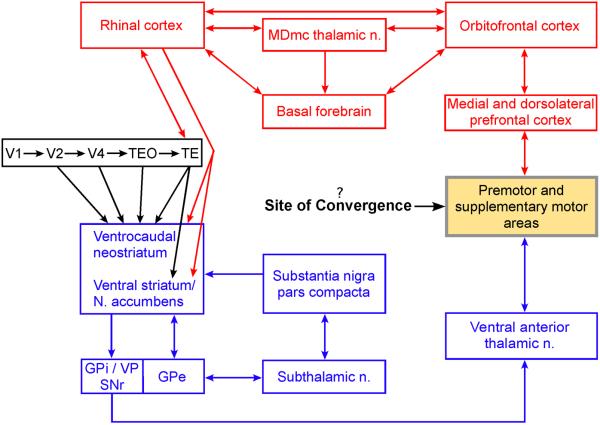Figure 4.
The neural underpinnings of the behavioral and cognitive learning systems in vision, illustrating information flow through some of the major components of each circuit. The ventral visual stream (in black) projects to both the ventrocaudal neostriatum and the rhinal cortices (see also Fig. 1), which constitute the initial components of the cortico-basal ganglia system (in blue; Alexander et al., 1986; Parent & Hazrati, 1995) and the cortico-limbic system (in red; Mesulam & Mufson, 1984; Mesulam et al., 1986; Kondo et al., 2005; Aggleton & Mishkin, 1983; Meunier et al., 1997), respectively. The principal neuromodulator in the cortico-basal ganglia system is dopamine, which is synthesized by neurons in the substantia nigra, pars compacta; and a principal neuromodulator in the cortico-limbic system is acetylcholine, synthesized by neurons in the basal forebrain, which projects not only to structures within this system but also to the entire cortical mantle including the ventral visual stream. The role of the direct projections from the rhinal cortex to the striatum is unknown, but one possibility is that they provide the visuo-striatal circuit with the products of stimulus configural learning (see Discussion). Major output targets of the basal ganglia are the premotor and supplementary motor areas of the frontal cortex. Because these motor-related areas are also targeted by the cortico-limbic system via the medial and dorsolateral prefrontal cortex, they could be the site of integration and collaboration between the two learning systems (see Discussion). Abbreviations: GPe, external segment of the globus pallidus; GPi, internal segment of the globus pallidus; MDmc, magnocellular portion of the medial dorsal nucleus; N., nucleus; SNr, reticulata portion of substantia nigra; VP, ventral pallidum.

